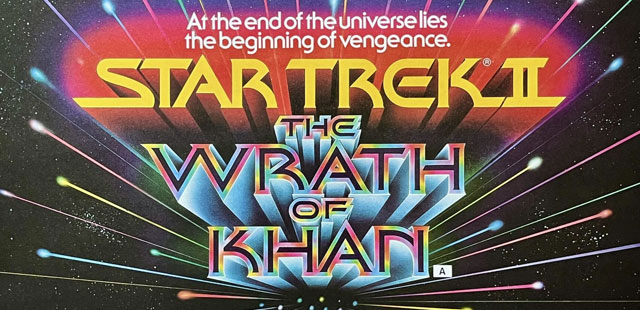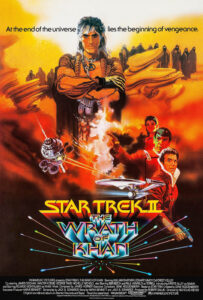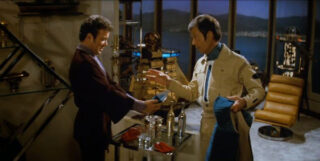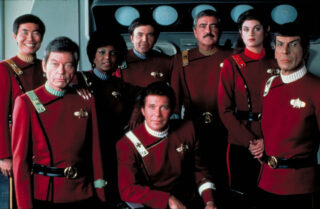
Palmer’s Trek, the unwatched frontier. These are the voyages of Agent Palmer. On his continuing mission: to explore Star Trek. To seek out its numerous series and movies. To boldly go where many fans have gone before!
This movie was something special, as it marks for me a return to form for the franchise and getting back to the roots of what made it so special in The Original Series. Of all the films in the franchise, this was the one that those Trek fans around me were most excited for me to experience.
So let’s get to it. We start this film in two familiar ways. First with another star field overture, this time by James Horner (more on that later), and then the film kicks off properly with a Captain’s Log. This was superb. It wasn’t just that it’s the way these films should be started, it’s the fact that it was missing at the start of The Motion Picture!
There are plenty of other things that return in this film as well, because it has more of an overall feeling of The Original Series than The Motion Picture in many ways. Most notably, the interpersonal communications between McCoy, Spock, and Captain Kirk is amiable and tense, friendly and adversarial, like fans who grew up with the series came to expect. It’s also something that was mostly missing from the previous film.
 Also, unlike the previous film, The Wrath of Khan has a true villain. Ricardo Montalban is back in the titular role of Khan Noonien Singh, who we haven’t seen nor heard of since the first season of The Original Series in “Space Seed.” And like a reprisal from that episode, Khan and Kirk match wits throughout this film.
Also, unlike the previous film, The Wrath of Khan has a true villain. Ricardo Montalban is back in the titular role of Khan Noonien Singh, who we haven’t seen nor heard of since the first season of The Original Series in “Space Seed.” And like a reprisal from that episode, Khan and Kirk match wits throughout this film.
It’s a simpler plot. Sure, there’s a complicated Genesis machine, which is perfectly summarized by McCoy when he says, “According to myth, the Earth was created in six days. Now, watch out! Here comes Genesis, we’ll do it for you in six minute.” That’s all a backseat to one core piece to this entire film: revenge. I was surprised to see the old “Revenge is a dish best served cold” quote attributed to the Klingons, but why not? It makes sense in this franchise for that to be the case.
The style of this film is greatly improved over The Motion Picture. The uniforms are more naval than aeronautical, but at least they have some color and personality, though I still wonder why the color scheme and purpose of departmental uniforms from the series is still not carried through on the big screen. The exploratory jackets worn by the crew of the Enterprise may be some of the most fashionable and functional jackets in cinema.
The graphics have improved as we’re beaming people aboard in a new way, the consoles have better graphical interfaces, and of course, the bridge has returned to a sense of, well, sense. The science officer is no longer behind the captain. Kirk no longer has to 180 himself in his chair to talk to Spock.
Of course, it isn’t only Kirk sitting in the Captain’s chair. A young Kirstie Alley plays Saavik, a Vulcan, who’s simulator mission is one of the first things we encounter in this film. And Saavik, as well as, the rest of the training crew are also pieces in the larger puzzle of aging.
Yeah, that’s right. And in this concept of feeling old we also get a reprisal from the pilot episode “The Cage.” In that episode, Captain Pike and Dr. Boyce have a conversation over a hard drink with Boyce saying, “Sometimes a man’ll tell his bartender things he’ll never tell his doctor.”
The conversation that follows in that episode is about Captain Pike wanting to leave, while his destiny remains as a ship captain, at least to Boyce and to those who know him. In this film, Captain Kirk, on his birthday, has the same conversation in the other direction. This time McCoy is imploring him to regain his old command.
 In both instances, Boyce and McCoy understand that while it may be tough, Pike and Kirk both belong at the helm of the Enterprise. It’s nice to see such a conversation make its way, even reversed as it is, onto the big screen in this franchise.
In both instances, Boyce and McCoy understand that while it may be tough, Pike and Kirk both belong at the helm of the Enterprise. It’s nice to see such a conversation make its way, even reversed as it is, onto the big screen in this franchise.
Now, let’s talk about Khan. Khan is just a frozen terrorist out of time who, it became clear while watching this, is just the Star Trek version of what would become Simon Phoenix, who frankly did it better 11 years later in Demolition Man.
Khan is delightful at times in a Shakespearian way. Being an overly dramatic foil for Captain Kirk is actually a good quality for the villain of this film. But despite its title, this film isn’t about Khan at all; it’s about Captain Kirk.
We learn how he “changed the conditions of the test,” which is how he saved his crew when he went through the Kobayashi Maru training exercise. We learn that Kirk doesn’t “believe in a no-win scenario” and we realize that he’s not really faced death, though he watches one of Scotty’s best trainees die right in front of him, and he’s been witness to almost as many deaths of his crew as there were episodes in The Original Series. But sure, I’ll let this movie and the trainee Saavik go on about how he’s never “faced death.”
He has actually faced death countless times if you consider the encounters he’s faced during his first stint as Captain of the Enterprise, but that’s something that after ruminating about the movie dawned on me as the most troubling.
Forty-one-year-old spoiler alert: I did not know Spock dies at the end of this film, but it was rough to see and even rougher to comprehend how hard that was.
 I understand most people don’t deluge themselves in the Trek universe the way I have, but Kirk watched his unborn child and the woman whom he loved and who was carrying that child die. Sure, it’s not the same as losing your first mate and best friend, but it’s got to be close. Otherwise, Kirk is a bit unfeeling to have never faced death.
I understand most people don’t deluge themselves in the Trek universe the way I have, but Kirk watched his unborn child and the woman whom he loved and who was carrying that child die. Sure, it’s not the same as losing your first mate and best friend, but it’s got to be close. Otherwise, Kirk is a bit unfeeling to have never faced death.
As a morality play, Star Trek through its early years isn’t always about the good guys coming out unscathed. The idea that Kirk “cheated” through the Kobayashi Maru may have been incidental to the story since Saavik accuses him of cheating, but since his training days he’s been in some very tough spots, which is how in this film he can say, with conviction, that he doesn’t “believe in a no-win scenario.”
Well, of course he doesn’t. He’s Captain James Tiberious Kirk, and he’s faced more death defying adventures than most captains ever dream of. And so I’m at an impasse here, because this film has returned Star Trek as a franchise to the roots from which I fell in love with it, and yet it makes a point of glossing over most of those adventures.
And I don’t mean to gloss over Spock’s “death” as it were, but I’ve seen my fair share of movies. This one in particular goes out of its way to show the casket, and through now seasons of bickering with McCoy about how he’s not entirely human, I had a feeling it wasn’t the last of our beloved first mate Vulcan. Then I found out that Star Trek III is subtitled the Search for Spock, and well, it’s hard to mourn too much. However, Captain Kirk’s speech is beyond breathtaking.
“We are assembled here today to pay final respects to our honoured dead. And yet it should be noted that in the midst of our sorrow, this death takes place in the shadow of new life, the sunrise of a new world, a world that our beloved comrade gave his life to protect and nourish. He did not feel that sacrifice a vain or empty one… and we will not debate his profound wisdom at these proceedings. Of my friend, I can only say this. Of all the souls I have encountered in my travels, …his was the most …human.”
 And on a scale this size, especially when the film was released, before anyone knew the title for Star Trek III, I can see how emotional that scene would have been. That scene, like so many others, is underscored by the great James Horner.
And on a scale this size, especially when the film was released, before anyone knew the title for Star Trek III, I can see how emotional that scene would have been. That scene, like so many others, is underscored by the great James Horner.
This isn’t a background orchestration that’s just there as a highlight in The Motion Picture. This is a full-blown, the-music-is-a-character mechanism that’s pushing the narrative along with all of the rest of the crew.
Horner absolutely kills it in a way that makes me think he took some notes from John Williams about how to influence a film with score, because it’s reminiscent of the themes and musical characterizations from Star Wars’ original trilogy of the same time.
And we’re in that era. This film came out in 1982, two years after Star Wars returned to the big screen with Empire Strikes Back. The big action sci-fi flick era is now in full swing. And while there are more to come, I’m pleased that the powers in charge of Star Trek returned to more of that Original Series feel.
In fact, I have more optimism going into the next film than I did coming into this one. The fact that the series appears to have self-corrected is wonderful. And I’m ready to Search for Spock.